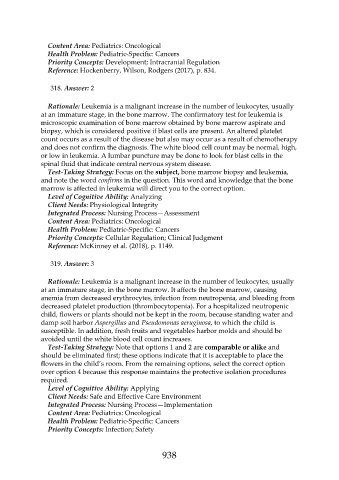Page 938 - Saunders Comprehensive Review For NCLEX-RN
P. 938
Content Area: Pediatrics: Oncological
Health Problem: Pediatric-Specific: Cancers
Priority Concepts: Development; Intracranial Regulation
Reference: Hockenberry, Wilson, Rodgers (2017), p. 834.
318. Answer: 2
Rationale: Leukemia is a malignant increase in the number of leukocytes, usually
at an immature stage, in the bone marrow. The confirmatory test for leukemia is
microscopic examination of bone marrow obtained by bone marrow aspirate and
biopsy, which is considered positive if blast cells are present. An altered platelet
count occurs as a result of the disease but also may occur as a result of chemotherapy
and does not confirm the diagnosis. The white blood cell count may be normal, high,
or low in leukemia. A lumbar puncture may be done to look for blast cells in the
spinal fluid that indicate central nervous system disease.
Test-Taking Strategy: Focus on the subject, bone marrow biopsy and leukemia,
and note the word confirms in the question. This word and knowledge that the bone
marrow is affected in leukemia will direct you to the correct option.
Level of Cognitive Ability: Analyzing
Client Needs: Physiological Integrity
Integrated Process: Nursing Process—Assessment
Content Area: Pediatrics: Oncological
Health Problem: Pediatric-Specific: Cancers
Priority Concepts: Cellular Regulation; Clinical Judgment
Reference: McKinney et al. (2018), p. 1149.
319. Answer: 3
Rationale: Leukemia is a malignant increase in the number of leukocytes, usually
at an immature stage, in the bone marrow. It affects the bone marrow, causing
anemia from decreased erythrocytes, infection from neutropenia, and bleeding from
decreased platelet production (thrombocytopenia). For a hospitalized neutropenic
child, flowers or plants should not be kept in the room, because standing water and
damp soil harbor Aspergillus and Pseudomonas aeruginosa, to which the child is
susceptible. In addition, fresh fruits and vegetables harbor molds and should be
avoided until the white blood cell count increases.
Test-Taking Strategy: Note that options 1 and 2 are comparable or alike and
should be eliminated first; these options indicate that it is acceptable to place the
flowers in the child’s room. From the remaining options, select the correct option
over option 4 because this response maintains the protective isolation procedures
required.
Level of Cognitive Ability: Applying
Client Needs: Safe and Effective Care Environment
Integrated Process: Nursing Process—Implementation
Content Area: Pediatrics: Oncological
Health Problem: Pediatric-Specific: Cancers
Priority Concepts: Infection; Safety
938

